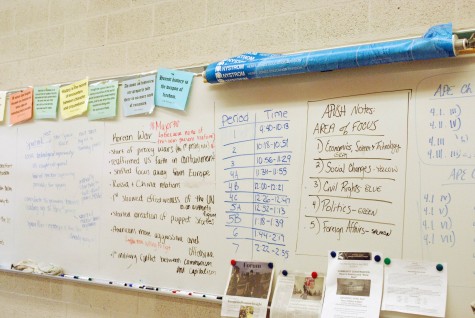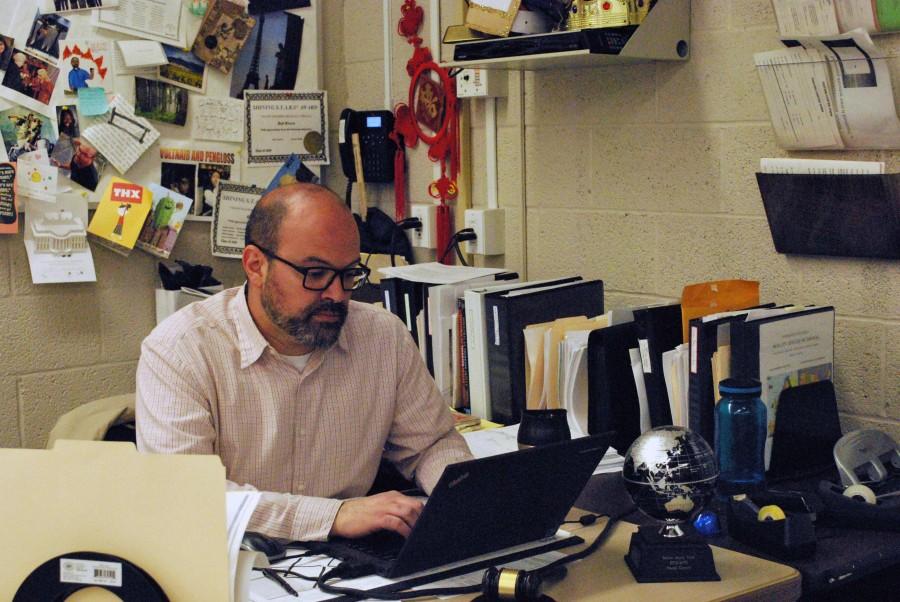In addition to Honors and AP US History, Robert Rivera also teaches AP European History at SHS, which is considered by many to be one of the most challenging AP courses.
Honors US History discontinued from SHS Program of Studies
April 21, 2016
This January as Solon High School freshmen scheduled their sophomore year classes, one of SHS’s sophomore year staples, Honors US History, was missing from the menu.
In the past, Honors US History (HUSH) has served as a stepping stone for students who took College Preparatory (CP) World History as a freshman but are aiming to take AP level history courses, such as AP Comparative Government or AP European History, as an upperclassman.
Sophomore and current HUSH student Derek Walton said that he chose HUSH as a middle ground between CP and AP.
“I heard that regular US History was really easy and I wanted to challenge myself, but I didn’t think that I was ready enough to move onto an AP class,” he said.
The decision to discontinue offering HUSH has been in discussion for many years due to a change in curriculum, according to SHS Assistant Principal Terry Brownlow.
“In 2010, the state of Ohio came out with new learning standards,” Brownlow said. “As you look at those, there are certain courses, and history is one of them, [where] it becomes very difficult to truly differentiate in relationship to a CP and an Honors level because the content is the same. ”
Also, with the introduction of new graduation requirements and end-of-course exams for American History, students in both Honors and CP US History are facing the same test.
“For the first time they face a state test to graduate that is actually, directly related to US History,” said SHS History teacher Robert Rivera. “In the past it was the OGT and the OGT, as students well know, covered everything. So therefore, Honors and CP could really diverge. We can’t diverge anymore, because we both have to teach to get students ready for the exact same test.”
Rivera, who has taught HUSH for the past eight years and has taught both CP US History and AP US History in his time at SHS, has seen CP US History’s curriculum change as a result of the 2010 standard change and the introduction of end-of-course exams.

Rivera engages students through use of interactive white board activities that aim to tie various historical events together.
“CP, as the teachers have done, has completely raised its game,” he said. “So the net result for me, and I can only speak for me, [was that] I saw value in merging the two because…our units of study are the same now…the curriculum is the same now, and we both face the same test. Both students and teachers are now going to be assessed based on how students do on the same test.”
In the past, there were more differences between the CP and Honors curriculum, and the courses were more easily differentiated.
“The big difference was that [Honors] required more writing than CP, had outside reading books and [Honors] also divided [the] units differently,” Rivera said. “We merged more material into single units where CP had divided it up into smaller units, but now the units align.”
As SHS moved to incorporating the Ohio Department of Education’s new requirements in 2010, students taking CP US History began to be expected to complete tasks that were traditionally “Honors level.”
“All of our kids need to be able to do document based questions, all of our kids need to be able to do these kinds of things and so there really [are] only two levels,” Brownlow said.
For students that want more of a challenge, AP US History (APUSH) is still offered. APUSH covers a wider span of history in the same amount of time and culminates in an end of the year AP test, for which students can receive college credit.
Brownlow suggests that students unsure of which course to pick should consult both their current history teacher and their guidance counselor.
“They need to talk to their current teacher, whether they’re in [CP] World History or AP World History and have that conversation,” she said. “Their guidance counselor is a resource, because I think it’s also looking at their big picture. Not just looking at ‘should I take AP history,’ but ‘am I also taking Honors English and AP Bio’. Your guidance counselor and your current teacher should be able to guide you in those regards.”
